Sweet Woodruff Ground Cover: A Versatile and Low-Maintenance Option for Your Garden
Sweet woodruff, also known as Galium odoratum, is a popular ground cover that is native to Europe and Asia. This perennial plant is a member of the Rubiaceae family and is known for its sweet scent and delicate white flowers. Sweet woodruff is an excellent choice for gardeners looking for a low-maintenance ground cover that is both beautiful and functional.
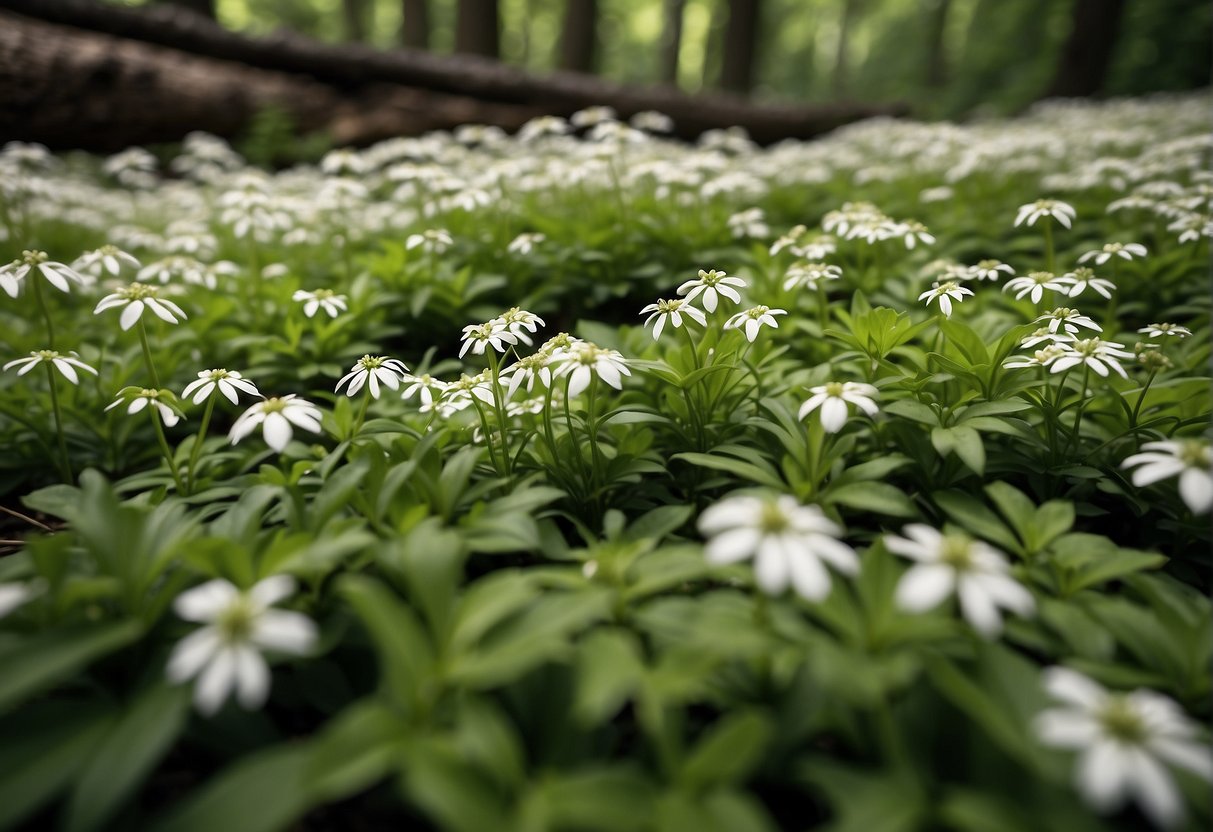
Sweet woodruff is a versatile plant that can grow in a variety of conditions. It prefers moist, well-drained soil and partial shade, but can also tolerate full sun and dry soil. Its low-growing habit makes it an excellent choice for planting under trees or in areas where other plants struggle to grow. Sweet woodruff is also known for its ability to suppress weeds, making it a popular choice for gardeners looking to reduce the amount of time spent weeding.
Botanical Profile and Varieties
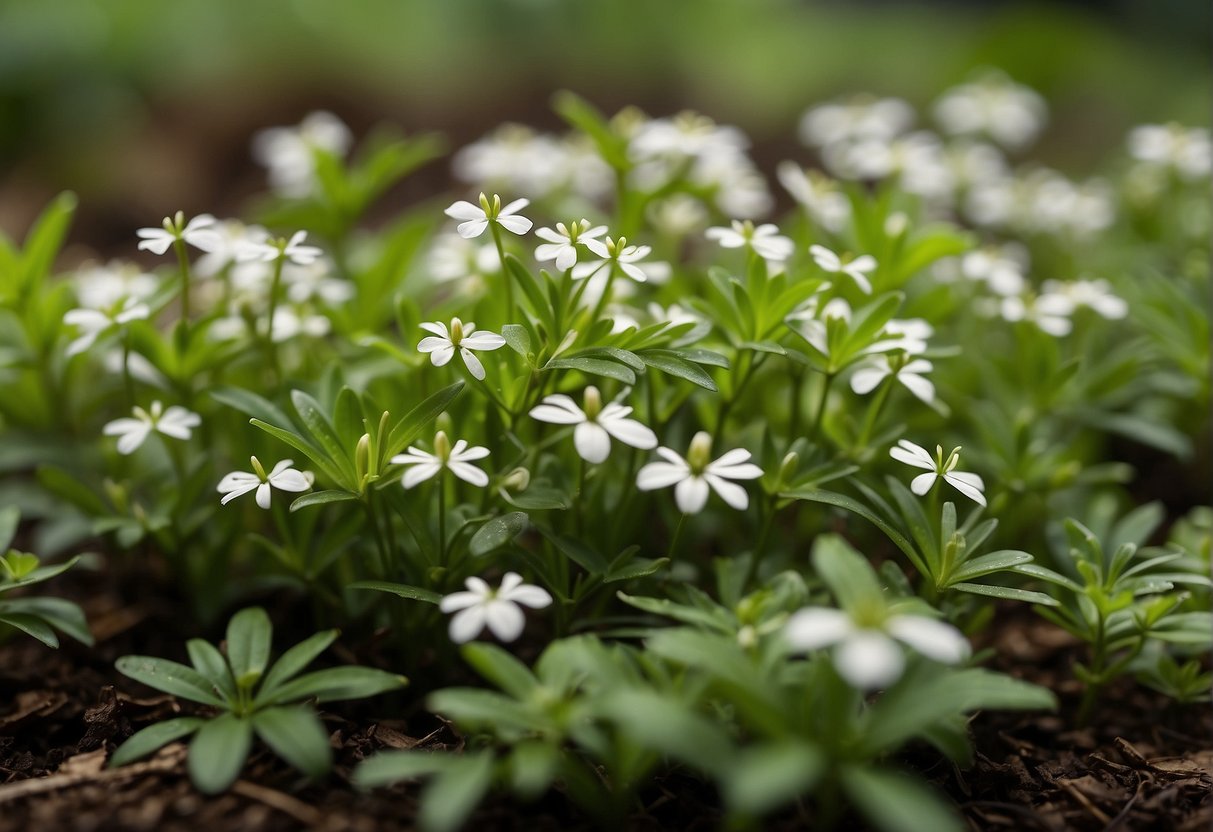
Species Overview
Sweet woodruff, also known as Galium odoratum, is a perennial ground cover that belongs to the Rubiaceae family. It is native to Europe, North Africa, and Western Asia. Sweet woodruff is a popular plant for its fragrant white flowers and sweet scent. It grows up to 30 cm in height and spreads about 45 cm wide.
Sweet Woodruff Characteristics
Sweet woodruff is a low-maintenance plant that is easy to grow and care for. It prefers partial to full shade and moist, well-drained soil. It is often used as a ground cover in woodland gardens, rock gardens, and borders. Sweet woodruff produces small white flowers in spring, which are followed by small fruits.
There are several varieties of sweet woodruff available, including ‘Album’, which has pure white flowers, and ‘Flore Pleno’, which has double flowers. Sweet woodruff can be propagated by division or cuttings.
Overall, sweet woodruff is a versatile and attractive ground cover that adds beauty and fragrance to any garden. Its sweet scent makes it a popular choice for sweet-scented bedstraw.
Planting and Growing Conditions
Soil Requirements
Sweet woodruff ground cover grows best in moist, well-drained soil. It prefers loamy soil that is slightly acidic, with a pH between 5.5 and 7.0. The plant can tolerate a range of soil conditions, including dry soil, but it will not thrive in wet or waterlogged soil.
Lighting Needs
Sweet woodruff is a shade-loving plant that thrives in partial to full shade. It can tolerate some sunlight, but too much direct sunlight can damage the leaves and cause the plant to wilt. When planting sweet woodruff, choose a location that receives partial to full shade throughout the day.
Watering and Humidity
Sweet woodruff requires regular watering to keep the soil moist but not waterlogged. The plant prefers moist but well-drained soil and will not tolerate drought. During hot, dry weather, it may be necessary to water the plant more frequently to prevent wilting. Sweet woodruff also prefers high humidity and will not thrive in dry air.
Overall, sweet woodruff ground cover is an easy-to-grow plant that requires little maintenance once established. By providing the right soil, lighting, and watering conditions, gardeners can enjoy the beauty and fragrance of this lovely ground cover for years to come.
Maintenance and Care
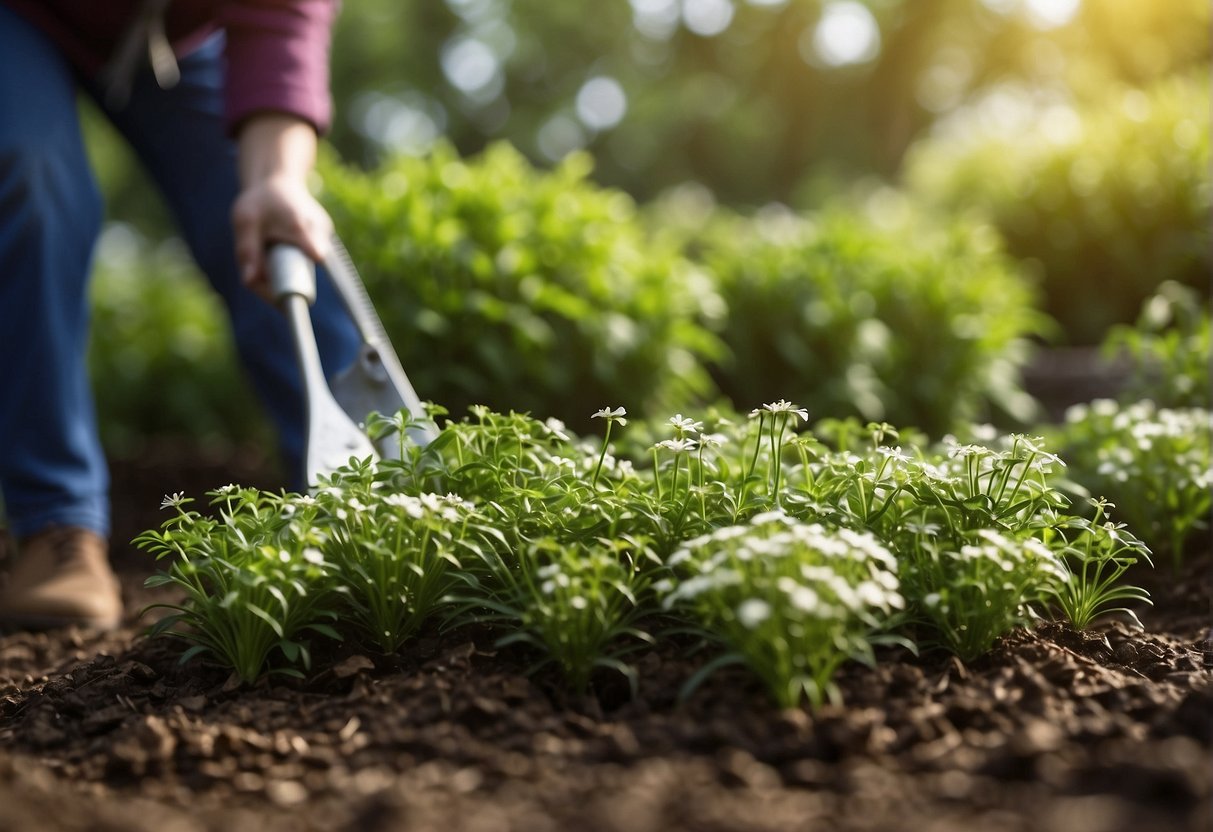
Sweet woodruff ground cover is an easy-to-care-for plant that requires minimal maintenance. However, it does need some attention to keep it looking healthy and vibrant. Here are some tips for maintaining and caring for sweet woodruff ground cover:
Fertilization and Mulching
Sweet woodruff ground cover does not require much fertilization. However, a light application of a balanced fertilizer in the spring can help promote healthy growth. Mulching around the plant can also help retain moisture and suppress weeds.
Pruning and Weed Control
Sweet woodruff ground cover does not require much pruning. However, if it starts to spread too much, it can be trimmed back to keep it in check. It is also important to control weeds around the plant to prevent competition for nutrients and water.
Pest and Disease Management
Sweet woodruff ground cover is generally not susceptible to many pests or diseases. However, slugs can sometimes be a problem, especially in damp conditions. Regular inspections and handpicking of slugs can help control their population. Powdery mildew and rust can also occur, but these can usually be prevented by providing good air circulation and avoiding overhead watering.
Overall, sweet woodruff ground cover is a low-maintenance plant that can add beauty and interest to any garden. With proper care and attention, it can thrive and provide years of enjoyment.
Propagation and Cultivation
Seed Germination
Sweet woodruff can be propagated by seeds, but it can be a slow process. The seeds should be sown in the fall or early spring, and they need to be kept moist until they germinate. It is important to note that the germination rate of sweet woodruff seeds is often low, so it may be necessary to sow more seeds than you need.
Division and Transplanting
Sweet woodruff can also be propagated by division. The best time to divide sweet woodruff is in the spring, just as new growth is beginning to emerge. The plant can be divided by carefully digging up the clump and separating the roots into smaller sections. Each section should have a healthy root system and several stems.
When transplanting sweet woodruff, it is important to choose a location with well-draining soil and partial shade. The plant prefers moist soil but can tolerate periods of drought once established. It is also important to note that sweet woodruff can spread quickly through creeping rhizomes, so it may be necessary to contain the plant by planting it in a container or using a barrier around the planting area.
Overall, sweet woodruff is a relatively easy plant to propagate and cultivate. With the right conditions, it can thrive and provide a beautiful ground cover for your garden.
Landscape and Ecological Benefits
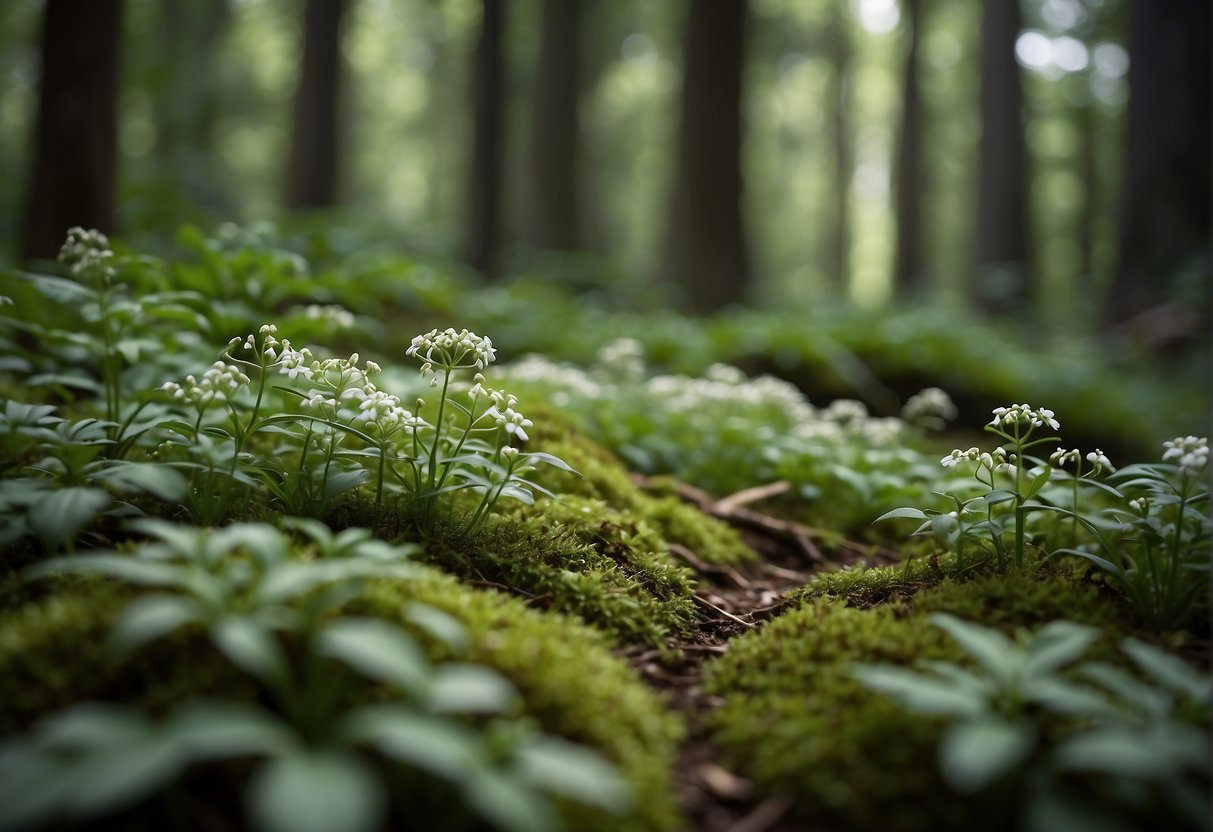
Wildlife Attraction
Sweet woodruff ground cover is an excellent addition to any garden or landscape that aims to attract wildlife. The fragrant flowers and foliage of this plant are known to attract butterflies, bees, and other pollinators. The sweet scent of the plant also attracts a wide range of insects, making it a great choice for gardeners looking to create a diverse and thriving ecosystem.
Companion Planting
Sweet woodruff is an excellent companion plant for a variety of other species, including hostas and master of the woods. When planted together, these plants can create a beautiful and diverse ground cover that provides shade and protection for a range of other plants and wildlife.
In addition to its ecological benefits, sweet woodruff is also easy to grow and maintain, making it an ideal choice for gardeners of all skill levels. Its low-growing habit and attractive foliage make it a great choice for use as a ground cover in a shade garden, where it can help to reduce soil erosion and retain moisture.
Overall, sweet woodruff ground cover is an excellent choice for gardeners looking to create a beautiful and diverse landscape that is also beneficial for wildlife. With its fragrant flowers, attractive foliage, and ease of care, it is a versatile and valuable addition to any garden or landscape.
Frequently Asked Questions
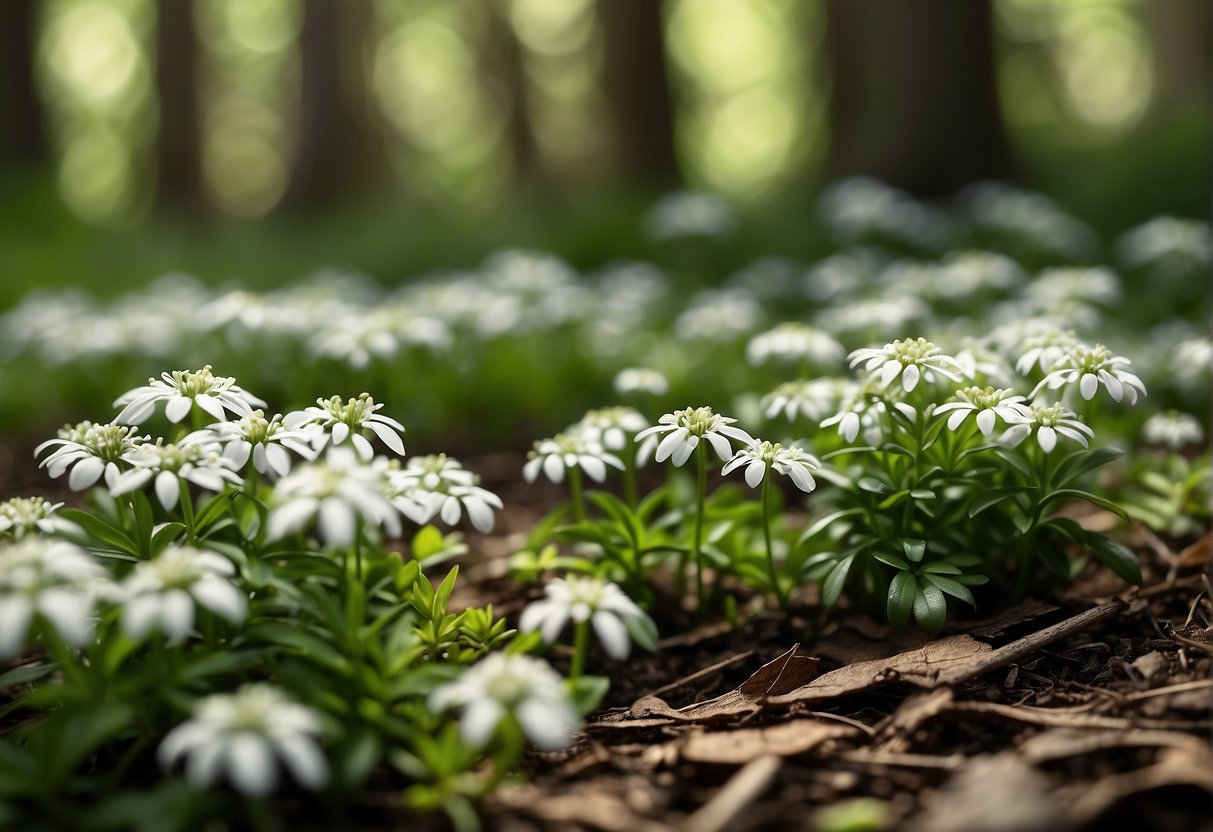
How should I space sweet woodruff when planting it as a ground cover?
Sweet woodruff should be spaced approximately 6-8 inches apart when planting as a ground cover. This will allow the plants to fill in and create a dense carpet-like effect.
What size does sweet woodruff typically reach when fully grown?
Sweet woodruff typically grows to be 6-12 inches in height and can spread up to 2 feet wide.
What are the best practices for caring for sweet woodruff ground cover?
Sweet woodruff prefers moist, well-drained soil and partial shade. It is important to keep the soil consistently moist, especially during hot and dry periods. Sweet woodruff can benefit from a layer of organic mulch to help retain moisture and suppress weeds.
Where can I purchase sweet woodruff plants or seeds?
Sweet woodruff plants and seeds can be purchased from nurseries, garden centers, and online retailers. It is important to ensure that the plants or seeds are from a reputable source and are not invasive species.
Can sweet woodruff become invasive, and how can I control its spread?
Sweet woodruff can become invasive if not properly managed. It is important to regularly prune and thin out the plants to prevent overcrowding and encourage air circulation. If sweet woodruff begins to spread too aggressively, it can be dug up and removed or treated with an herbicide.
What are some recommended companion plants for sweet woodruff?
Sweet woodruff pairs well with other shade-loving plants such as hostas, ferns, and bleeding hearts. It can also be used as a ground cover under trees and shrubs.

